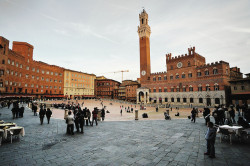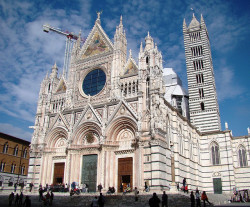A trip to Tuscany is not just charming Florence or the incredible tower of Pisa. One of ‘must see’ cities in Tuscany is Siena, which is included in the UNESCO World Heritage List due to the unique architecture of its historical town centre. According to legend, Siena was founded by Senio, the son of Remo, the founder of Rome. So do not be surprised to see in the city the sculptures of legendary founders of Rome, Remus and Romulus, suckling milk of a she-wolf. So what highlights of Siena you must see?
Piazza del Campo
 Piazza del Campo in Siena is considered one of the most beautiful places in the world. Since the 13th century, this square has been the centre of Siena, teeming with life, and finally it became a birthplace of famous Palio di Siena Horse Race. The square has a peculiar shape, which resembles a shell (it is not just round but also concave). A wonderful marble fountain, created in the beginning of the 15th century by sculptor Jacopo della Quercia, located in front of Palazzo Pubblico delights tourists and townspeople on a hot summer day. Typically, the square is full of hustle and bustle, tourists willingly sit down on the pavement to rest or to explore the buildings in the square and the tower of Torre del Mangia.
Piazza del Campo in Siena is considered one of the most beautiful places in the world. Since the 13th century, this square has been the centre of Siena, teeming with life, and finally it became a birthplace of famous Palio di Siena Horse Race. The square has a peculiar shape, which resembles a shell (it is not just round but also concave). A wonderful marble fountain, created in the beginning of the 15th century by sculptor Jacopo della Quercia, located in front of Palazzo Pubblico delights tourists and townspeople on a hot summer day. Typically, the square is full of hustle and bustle, tourists willingly sit down on the pavement to rest or to explore the buildings in the square and the tower of Torre del Mangia.
Palazzo Pubblico
Piazza del Campo lures many curious visitors not only for its extraordinary form. Palazzo Pubblico, which has been the seat of the political power of the city since the 14th century, is also worth attention. The first government consisted of only 9 residents of Siena, who managed to turn a small town into a place of extraordinary beauty, enchanting tourists from all over the world. Interestingly, the government commanded locals to build their houses observing strict rules of stylistic coherence, but, at the same time, they could not be more beautiful and larger than Palazzo Pubblico. Palazzo Pubblico is also home to Museo Civico – a museum that hosts breathtaking medieval and Renaissance interiors. Here you can see the world famous fresco by Ambrogio Lorenzetti (1337), depicting the allegory of good and bad government.
Torre del Mangia
Palazzo Pubblico can be proud of the second highest medieval tower in Italy, reaching the height of up to 88 m. Beyond all doubt, it is worth to mount 400 steps and to reach the observation deck on the top, offering breathtaking views of Piazza del Campo, the Cathedral of Siena, red roofs and hills that surround the city. It is said that during the construction at the foot of the tower were hidden some lucky coins and that at each corner of the tower has a stone with special Latin and Hebrew inscriptions, which has to protect against lightning and storms.
Duomo di Siena
 Tourists usually arrive at the Cathedral of Siena after seeing the beauties of Piazza del Campo, so they think that there cannot be something else of so spectacular. However, Siena’s Gothic Cathedral (begun in 1200) – the pride of the city – amazes everyone not only with its white and black marble frontage but also with its stupendous interior. The floor of the cathedral is a great piece of art, full of closely intertwined esoteric symbols and religious stories. There is the impressive Piccolomini Library and even more spectacular Cappella Piccolomini – a chapel, containing even four sculptures by Michelangelo. The cathedral also has masterpieces by Nicola Pisano and Donatello.Just behind Duomo di Siena there is Battistero di San Giovanni – the Baptistery of St. John, built in the middle of the 14th century. The most striking object of the baptistery is a baptismal font made of marble and bronze, created by the great artists of that period: Jacopo della Quercia, Giovanni di Turino, Lorenzo Ghiberti and Donatello.
Tourists usually arrive at the Cathedral of Siena after seeing the beauties of Piazza del Campo, so they think that there cannot be something else of so spectacular. However, Siena’s Gothic Cathedral (begun in 1200) – the pride of the city – amazes everyone not only with its white and black marble frontage but also with its stupendous interior. The floor of the cathedral is a great piece of art, full of closely intertwined esoteric symbols and religious stories. There is the impressive Piccolomini Library and even more spectacular Cappella Piccolomini – a chapel, containing even four sculptures by Michelangelo. The cathedral also has masterpieces by Nicola Pisano and Donatello.Just behind Duomo di Siena there is Battistero di San Giovanni – the Baptistery of St. John, built in the middle of the 14th century. The most striking object of the baptistery is a baptismal font made of marble and bronze, created by the great artists of that period: Jacopo della Quercia, Giovanni di Turino, Lorenzo Ghiberti and Donatello.
La Fortezza Medicea
In 1500s Cosimo I de Medici made a wish to rebuild the old fortress of Charles V in Siena. Thus the powerful walls appeared on the outskirts of the city, but the fortress remained armed for a short while and since the beginning of the 20th century became a public place for concerts and cultural events. Under the arcs of the ancient fortress there is Enoteca Italiana, a wine-cellar, where you can order the degustation of best Italian wines and try local goods.

